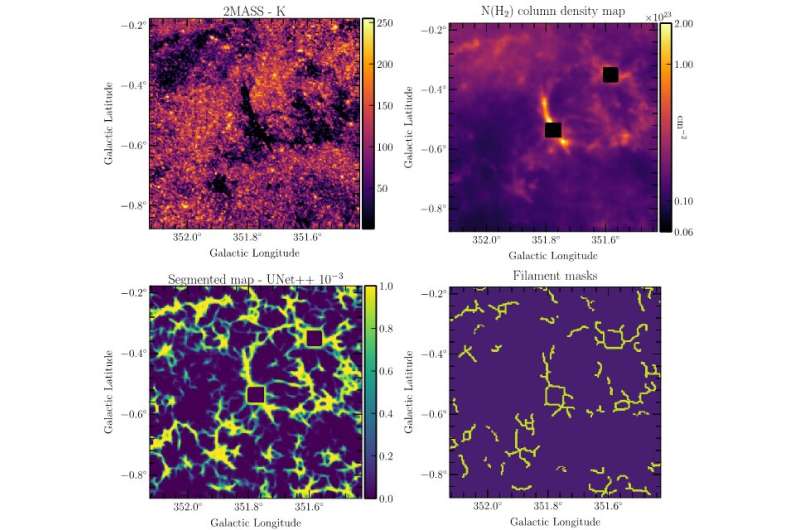
Star formation in galaxies takes place in filaments composed of gas (mainly hydrogen) and small solid particles called interstellar dust, which is mainly carbon. Depending on the location of these filaments and their physical properties (density, temperature) they can be difficult to detect in the data. In particular, low density filaments or filaments located in areas of very high emission are generally not detected.
In an innovative and interdisciplinary approach, a team in which some CNRS laboratories are involved, has tested the interest of supervised machine learning to try to detect filaments located in the plane of our galaxy. This approach is based on existing results of filament detection using classical extraction methods.
The extracted filaments are used to train convolutional networks of the Unet and Unet++ type. The trained model learns to recognize filaments and then allows researchers to create an image of the galactic plane in which each pixel is represented by its probability (between 0 and 1) of belonging to the learned filament class.
The results of the learning approach show that this method can detect filaments that were not previously identified by the usual detection methods. New filaments are detected and can be confirmed by an empirical approach using data available at other wavelengths that are currently not used in the learning process.
The findings are published in the journal Astronomy & Astrophysics.
The aim of this project, called BigSF, is to study star formation in our galaxy by combining the large amount of available data with machine learning.
More information: A. Zavagno et al, Supervised machine learning on Galactic filaments, Astronomy & Astrophysics (2022). DOI: 10.1051/0004-6361/202244103
Provided by CNRS
Citation: Detecting galactic filaments with machine learning (2023, January 23) retrieved 23 January 2023 from https://ift.tt/FoyX3pE
This document is subject to copyright. Apart from any fair dealing for the purpose of private study or research, no part may be reproduced without the written permission. The content is provided for information purposes only.
"machine" - Google News
January 23, 2023 at 10:55PM
https://ift.tt/nhCwvGN
Detecting galactic filaments with machine learning - Phys.org
"machine" - Google News
https://ift.tt/wVSa8j4
https://ift.tt/wroObcN
Bagikan Berita Ini














0 Response to "Detecting galactic filaments with machine learning - Phys.org"
Post a Comment